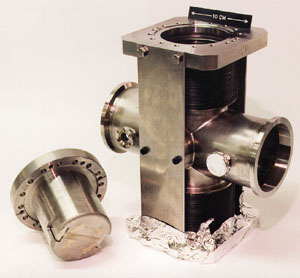
The “Roman pot” technique has become a time-honoured particle physics approach each time a new energy frontier is opened up, and CERN’s LHC proton collider, which can attain collision energies of 14 TeV, will be no exception. While other detectors look for spectacular head-on collisions, where fragments fly out at wide angles to the direction of the colliding beam, with Roman pots the intention is to get as close as possible to the beams and to intercept particles that have been only slightly deflected.
If two flocks of birds fly into each other, most of the birds usually miss a head-on collision. Likewise, when two counter-rotating beams of particles meet, most of the particles are only slightly deflected, if at all. Paradoxically, most of the particles in a collider do not collide. Of those particles that do, many of them just graze past each other, emerging very close to the particles that are sailing straight through.
These forward particles are also important for measuring the total collision rate (cross-section). In the same way as light diffracting around a small obstacle gives a bright spot in the centre of the geometric shadow, so the wave nature of particles gives a central spot of maximum “brightness”.
To pick up these forward particles means having detectors that venture as near to the path of the colliding beams as possible, like avid spectators at a motor race leaning over the safety barrier. This is where Roman pots come in.
Why Roman? They were first used by a CERNRome group in the early 1970s to study the physics at CERN’s Intersecting Storage Rings (ISR), the world’s first high-energy protonproton collider.
Why pots? The delicate detectors, able to localize the trajectory of subnuclear particles to within 0.1 mm, are housed in a cylindrical vessel. These “pots” are connected to the vacuum chamber of the collider by bellows, which are compressed as the pots are pushed towards the particles circulating inside the vacuum chamber.
The physics debut of these Roman pots was a physics milestone. Experiments at lower energies had found that the proton interaction rate was shrinking, and physicists feared that the proton might shrink out of sight at higher energies. Using the Roman pots, the first experiments at the ISR were able to establish rapidly that the interaction rate of protons (total cross-section) in fact increases at the new energies probed by the ISR.
In their retracted position, the Roman pots do not obstruct the beam, thus leaving the full aperture of the vacuum chamber free for the fat beams encountered during the injection process. Once the collider reaches its coasting energy, the Roman pot is edged inwards until its rim is just 1 mm from the beam, without upsetting the stability of the circulating particles.
Each time a new energy regime is reached in a particle collider, Roman pots are one of the first detectors on the scene, gauging the cross-section at the new energy range. After the ISR, Roman pots have been used at CERN’s protonantiproton collider, Fermilab’s Tevatron protonantiproton collider and the HERA electronproton collider at the DESY laboratory, Hamburg.
In the future, Roman pots will again have their day in the TOTEM experiment at CERN’s LHC proton collider.





